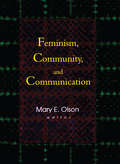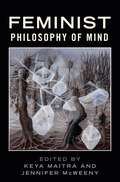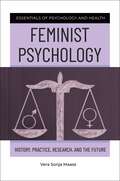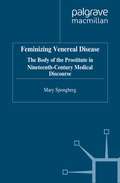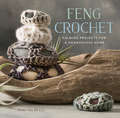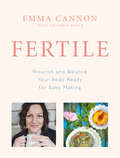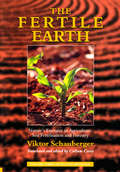- Table View
- List View
Female Reproductive Organs (SEB tactile)
by RnibA diagram showing the female reproductive organs, with textures used to differentiate, and labels showing various parts.
Feminism, Community, and Communication
by Betty Mackune-Karrer Mary E Olson. . . from the minds of therapists on the cutting edge!This informative, innovative collection brings together the work of a group of “scholar-therapists,” all women, who have met regularly for ten years to discuss family therapy, gender, and postmodern ideas. The major themes--feminism, community, and communication--are taken in new directions. Feminism, Community, and Communication rethinks therapy, research, teaching, and community work with a renewed emphasis on collaboration, intersubjectivity, and the process of communication as a world-making and identity-making activity. The issues of gender, culture, religion, race, and class figure prominently in this book.In Feminism, Community, and Communication you'll find descriptions of: communal perspectives for therapists that stress listening and understanding over interpreting and knowing the power of love and spirituality in relation to organizational consultation to an agency beset by racial division research on anorexia and what it means a mentoring project for rural girls the Bar/Bat Mitzva as therapy an ethnographic study of Lebanese womenFeminism, Community, and Communication takes an exciting, fresh look at these three intertwined concepts, representing a way of thinking and doing therapy, research, community work, and training that highlights the ethical dimension of each. The book takes the position that human beings are meaning-makers in a common world, and not simply objects to be scrutinized or assessed by “experts.”
Feminism, Community, and Communication
by Betty Mackune-Karrer Mary E Olson. . . from the minds of therapists on the cutting edge!This informative, innovative collection brings together the work of a group of “scholar-therapists,” all women, who have met regularly for ten years to discuss family therapy, gender, and postmodern ideas. The major themes--feminism, community, and communication--are taken in new directions. Feminism, Community, and Communication rethinks therapy, research, teaching, and community work with a renewed emphasis on collaboration, intersubjectivity, and the process of communication as a world-making and identity-making activity. The issues of gender, culture, religion, race, and class figure prominently in this book.In Feminism, Community, and Communication you'll find descriptions of: communal perspectives for therapists that stress listening and understanding over interpreting and knowing the power of love and spirituality in relation to organizational consultation to an agency beset by racial division research on anorexia and what it means a mentoring project for rural girls the Bar/Bat Mitzva as therapy an ethnographic study of Lebanese womenFeminism, Community, and Communication takes an exciting, fresh look at these three intertwined concepts, representing a way of thinking and doing therapy, research, community work, and training that highlights the ethical dimension of each. The book takes the position that human beings are meaning-makers in a common world, and not simply objects to be scrutinized or assessed by “experts.”
Feminist History of Philosophy: The Recovery and Evaluation of Women's Philosophical Thought
by Eileen O’Neill Marcy P. LascanoOver the course of the past twenty-five years, feminist theory has had a forceful impact upon the history of Western philosophy. The present collection of essays has as its primary aim to evaluate past women’s published philosophical work, and to introduce readers to newly recovered female figures; the collection will also make contributions to the history of the philosophy of gender, and to the history of feminist social and political philosophy, insofar as the collection will discuss women’s views on these issues.The volume contains contributions by an international group of leading historians of philosophy and political thought, whose scholarship represents some of the very best work being done in North and Central America, Canada, Europe and Australia.
Feminist Interrogations Of Women's Head Hair
by Sigal Barak-Brandes Amit KamaFeminist scholarship has looked extensively at the perception of the body as a flexible construction of cultural and social dictates, but head hair has been often overlooked. Feminist Interrogations of Women's Head Hair brings new focus to this underrepresented topic through its intersections with contemporary socio-cultural contexts. Scholars from a wide range of disciplines investigate private and public meanings associated with female head hair, problematising our assumptions about its role and implications in the 21st Century. Readers are invited to reflect on the use of hair in popular culture, such as children’s television and pop album artwork, as well as in work by women artists. Studies examine the lived experiences of women from a range of backgrounds and histories, including curly-haired women in Israel, African American women, and lesbians in France. Other essays interrogate the connotations of women’s head hair in relation to body image, religion, and aging. Feminist Interrogations of Women's Head Hair brings together cultural discourses and the lived experiences of women, across time and place, to reveal the complex and ever-evolving significance of hair. It is an important contribution to the critical feminist thought in cultural studies, fashion studies, media studies, African American studies, queer theory, gerontology, psychology, and sociology.
Feminist Interrogations Of Women's Head Hair (PDF)
by Sigal Barak-Brandes Amit KamaFeminist scholarship has looked extensively at the perception of the body as a flexible construction of cultural and social dictates, but head hair has been often overlooked. Feminist Interrogations of Women's Head Hair brings new focus to this underrepresented topic through its intersections with contemporary socio-cultural contexts. Scholars from a wide range of disciplines investigate private and public meanings associated with female head hair, problematising our assumptions about its role and implications in the 21st Century. Readers are invited to reflect on the use of hair in popular culture, such as children’s television and pop album artwork, as well as in work by women artists. Studies examine the lived experiences of women from a range of backgrounds and histories, including curly-haired women in Israel, African American women, and lesbians in France. Other essays interrogate the connotations of women’s head hair in relation to body image, religion, and aging. Feminist Interrogations of Women's Head Hair brings together cultural discourses and the lived experiences of women, across time and place, to reveal the complex and ever-evolving significance of hair. It is an important contribution to the critical feminist thought in cultural studies, fashion studies, media studies, African American studies, queer theory, gerontology, psychology, and sociology.
Feminist Philosophy of Mind (Philosophy of Mind)
by Keya Maitra and Jennifer McweenyThis is the first collection of essays to focus on feminist philosophy of mind. It brings the theoretical insights from feminist philosophy to issues in philosophy of mind and vice versa. Feminist Philosophy of Mind thus promises to challenge and inform dominant theories in both of its parent fields, thereby enlarging their rigor, scope, and implications. In addition to engaging analytic and feminist philosophical traditions, essays draw upon resources in phenomenology, cross-cultural philosophy, philosophy of race, disability studies, embodied cognition theory, neuroscience, and psychology. The book's methods center on the collective consideration of three questions: What is the mind? Whose mind is the model for the theory? To whom is mind attributed? Topics considered with this lens include mental content, artificial intelligence, the first-person perspective, personal identity, other minds, mental illness, perception, memory, attention, desire, trauma, agency, empathy, grief, love, gender, race, sexual orientation, materialism, panpsychism, enactivism, and others. Each of the book's twenty chapters are organized according to five core themes: Mind and Gender&Race&; Self and Selves; Naturalism and Normativity; Body and Mind; and Memory and Emotion. The introduction traces the development of these themes with reference to the respective literatures in feminist philosophy and philosophy of mind. This context not only helps the reader see how the essays fit into existing disciplinary landscapes, but also facilitates their use in teaching. Feminist Philosophy of Mind is designed to be used as a core text for courses in contemporary disciplines, and as a supplemental text that facilitates the ready integration of diverse perspectives and women's voices.
Feminist Philosophy of Mind (Philosophy of Mind)
This is the first collection of essays to focus on feminist philosophy of mind. It brings the theoretical insights from feminist philosophy to issues in philosophy of mind and vice versa. Feminist Philosophy of Mind thus promises to challenge and inform dominant theories in both of its parent fields, thereby enlarging their rigor, scope, and implications. In addition to engaging analytic and feminist philosophical traditions, essays draw upon resources in phenomenology, cross-cultural philosophy, philosophy of race, disability studies, embodied cognition theory, neuroscience, and psychology. The book's methods center on the collective consideration of three questions: What is the mind? Whose mind is the model for the theory? To whom is mind attributed? Topics considered with this lens include mental content, artificial intelligence, the first-person perspective, personal identity, other minds, mental illness, perception, memory, attention, desire, trauma, agency, empathy, grief, love, gender, race, sexual orientation, materialism, panpsychism, enactivism, and others. Each of the book's twenty chapters are organized according to five core themes: Mind and Gender&Race&; Self and Selves; Naturalism and Normativity; Body and Mind; and Memory and Emotion. The introduction traces the development of these themes with reference to the respective literatures in feminist philosophy and philosophy of mind. This context not only helps the reader see how the essays fit into existing disciplinary landscapes, but also facilitates their use in teaching. Feminist Philosophy of Mind is designed to be used as a core text for courses in contemporary disciplines, and as a supplemental text that facilitates the ready integration of diverse perspectives and women's voices.
Feminist Psychology: History, Practice, Research, and the Future (Essentials of Psychology and Health)
by Vera Sonja MaassDetailing the field of feminist psychology since its origins, this book assesses its early figures, theory, and research as well as current and emerging theory and research and its associations with general feminist beliefs.Feminist psychology developed as a reaction to historical psychological thought initiated by men who controlled the theory and research of the field. By holding all of society to "norms" based in male behavior, this so-called "masculine psychology" effectively assigned women lower societal status than men and had disturbing effects on women's health and self-esteem.Feminist Psychology focuses on gender differences, social structure, and the values and principles of women's rights within the world's individual, social, and political spheres. Contrary to popular notion, feminist psychology does not involve man-hating, but instead focuses on loving the concept that women have equal potential to set and achieve goals and to contribute to society. In this volume, psychologist Vera Maass explains the history, theory, research, and current state of this growing field, which is becoming increasingly popular as colleges offer majors or concentrations in feminist psychology, and argues that women are both different from and equal to men.
Feminist Psychology: History, Practice, Research, and the Future (Essentials of Psychology and Health)
by Vera Sonja MaassDetailing the field of feminist psychology since its origins, this book assesses its early figures, theory, and research as well as current and emerging theory and research and its associations with general feminist beliefs.Feminist psychology developed as a reaction to historical psychological thought initiated by men who controlled the theory and research of the field. By holding all of society to "norms" based in male behavior, this so-called "masculine psychology" effectively assigned women lower societal status than men and had disturbing effects on women's health and self-esteem.Feminist Psychology focuses on gender differences, social structure, and the values and principles of women's rights within the world's individual, social, and political spheres. Contrary to popular notion, feminist psychology does not involve man-hating, but instead focuses on loving the concept that women have equal potential to set and achieve goals and to contribute to society. In this volume, psychologist Vera Maass explains the history, theory, research, and current state of this growing field, which is becoming increasingly popular as colleges offer majors or concentrations in feminist psychology, and argues that women are both different from and equal to men.
Feminist Social Work Theory And Practice (PDF)
by Lena Dominelli Jo CamplingFeminist theories of social work have been criticised in recent years for treating women as a uniform category and displaying insufficient sensitivity to the complex ways in which other social divisions (those of race, age, disability, etc. ) impact on gender relations. This major text by a leading writer in the field seeks to develop a new framework for feminist social work that takes on board postmodernist arguments to do with difference and power yet retains a commitment to collective solidarity and social change. As such, it will be essential reading for students, educators and practitioners alike in social work.
Feminizing Venereal Disease: The Body of the Prostitute in Nineteenth-Century Medical Discourse
by M. SpongbergIn the late-eighteenth century all women were considered potentially infectious to men but by the early-twentieth century only certain women were considered vectors of disease. By focusing on representations of the prostitute in medical and legal discourse, art, literature and religion this book will chart these shifts, while at the same time exploring broader concerns about construction of femininity and masculinity, the protection of male sexual privilege and the impact of feminism and eugenics on medicine, the law and popular culture.
Feng Crochet: Calming Projects for a Harmonious Home
by Nikki Van De CarFeng Crochet draws on the elements of Feng Shui to teach readers 30 peaceful, practical, crocheted crafts to infuse their spaces with positive energy and beautiful objects. Our homes are meant to be a refuge -- a place of calm, serene contemplation where we can recharge after a long day. Feng Crochet, the latest book from author and crafter Nikki Van De Car, teaches readers how to create a nurturing environment with simple, beautiful projects to crochet. Grouped by the five elements of Feng Shui (wood, fire, earth, metal, and water), the patterns in this book range from home decor (plant hangers, large baskets, lampshades, and scatter rugs) to small, precious items that add a touch of warmth and peace to any room (napkin rings, dreamcatchers, doilies, and curtain ties). Mindful prompts and meditations begin each project, while helpful tips on incorporating the principles of Feng Shui into both crafts and life are peppered throughout the book. Beautifully illustrated with full-color photography and charming line art, Feng Crochet asks crafters of all skill levels to look inward as they create objects to bring peace and tranquility to their most treasured spaces.
Feng Crochet: Calming Projects for a Harmonious Home
by Nikki Van De CarFeng Crochet draws on the elements of Feng Shui to teach readers 30 peaceful, practical, crocheted crafts to infuse their spaces with positive energy and beautiful objects. Our homes are meant to be a refuge -- a place of calm, serene contemplation where we can recharge after a long day. Feng Crochet, the latest book from author and crafter Nikki Van De Car, teaches readers how to create a nurturing environment with simple, beautiful projects to crochet. Grouped by the five elements of Feng Shui (wood, fire, earth, metal, and water), the patterns in this book range from home decor (plant hangers, large baskets, lampshades, and scatter rugs) to small, precious items that add a touch of warmth and peace to any room (napkin rings, dreamcatchers, doilies, and curtain ties). Mindful prompts and meditations begin each project, while helpful tips on incorporating the principles of Feng Shui into both crafts and life are peppered throughout the book. Beautifully illustrated with full-color photography and charming line art, Feng Crochet asks crafters of all skill levels to look inward as they create objects to bring peace and tranquility to their most treasured spaces.
Feng Shui: How To Create Harmony And Energy In The Spaces Of Your Heart And Home (Plain And Simple Ser.)
by Sarah BartlettA practical guide to the art of feng shui. Filled with easy-to-use tips and techniques for improving the energy in your life, this book will teach you to harmonize and lay out spaces in your home to enhance your personal energy, improve your overall wellbeing, and bring good fortune and balance into your life. Includes information on how to: Declutter to clear the energy in your home Use the Chinese bagua (number square) to map out rooms to enhance energy Employ the five elements to harmonize the energy of your home Use feng shui for the exterior of your home and outside landscaping This wonderful primer will be hailed by anyone interested in interior design, Chinese legend and lore, and the creation of healing and harmonious living spaces.
Feng Shui: The Complete Guide To The Art And Practice Of Feng Shui (Illustrated Encyclopedia)
by Lillian TooThe definitive encyclopedia of Feng Shui: bestselling author Lillian Too’s vibrant, comprehensive and pertinent guide to understanding and implementing an ancient practice for the new millennium.
The Feng Shui Bible: Godsfield Bibles (Godsfield Bibles #4)
by Simon G. BrownFrom understanding the basic principles of feng shui to mastering floor plans and using remedies to cure real-life problems, this definitive guide covers everything you need to know about this ancient art. It includes advice on moving house, tailoring feng shui to your personal requirements, choosing furnishings and deciding when to redecorate.The comprehensive directory shows you how you can apply feng shui to every aspect of your life - including your home, health, relationships, finances, career and spiritual life - to help you achieve your full potential, take control of your destiny and create a happier atmosphere at home.
Feng Shui For Dummies (Miniature Editions Ser.)
by David Daniel KennedyBenefit from the ancient Chinese art of Feng Shui Take a look around you. What do you see? Whether or not you're aware of it, your environment profoundly affects your health, wealth, family life, relationship, and yes, even your destiny. Feng Shui (pronounced fung shway), which means wind water, is the ancient Chinese study of harmony and energy flow between you and your physical surroundings. Now, Feng Shui For Dummies, 2nd Edition shows you how you can apply Feng Shui principles to your home (inside and out) and workplace (from window office to cubicle) in order to achieve a better life. Principles are explained in an easy-to-understand language Practical tips show you how to incorporate the traditions of Feng Shui to your everyday life Before-and-after illustrations and full-color photos of real-life Feng Shui makeovers in an all-new 8-page color insert Free of technical jargon and brimming with practical tips and advice, Feng Shui For Dummies shows you how to feel and access the energy of your environment and create harmony and happiness in your life. Feng Shui For Dummies (9781119643166) was previously published as Feng Shui For Dummies (9780470769324). While this version features a new Dummies cover and design, the content is the same as the prior release and should not be considered a new or updated product.
Feng Shui For Dummies
by David Daniel KennedyBenefit from the ancient Chinese art of Feng Shui Take a look around you. What do you see? Whether or not you're aware of it, your environment profoundly affects your health, wealth, family life, relationship, and yes, even your destiny. Feng Shui (pronounced fung shway), which means wind water, is the ancient Chinese study of harmony and energy flow between you and your physical surroundings. Now, Feng Shui For Dummies, 2nd Edition shows you how you can apply Feng Shui principles to your home (inside and out) and workplace (from window office to cubicle) in order to achieve a better life. Principles are explained in an easy-to-understand language Practical tips show you how to incorporate the traditions of Feng Shui to your everyday life Before-and-after illustrations and full-color photos of real-life Feng Shui makeovers in an all-new 8-page color insert Free of technical jargon and brimming with practical tips and advice, Feng Shui For Dummies shows you how to feel and access the energy of your environment and create harmony and happiness in your life. Feng Shui For Dummies (9781119643166) was previously published as Feng Shui For Dummies (9780470769324). While this version features a new Dummies cover and design, the content is the same as the prior release and should not be considered a new or updated product.
Fenugreek: Traditional and Modern Medicinal Uses
by Dilip Ghosh Prasad ThakurdesaiFor many centuries, fenugreek has been one of the most popular spices and vegetables serving as an integral part of culinary practices across many cultures. Fenugreek contains exceptional nutritional and medicinal properties, but scientific evidence for its potential health benefits has been considerably understudied and is beginning to grow. This book is a comprehensive compilation and documentation on the scientific profile of fenugreek and its phytoconstituents, including their most known applications and health benefits. It features a wide range of chapters written by highly experienced academics and industrial professionals. Topics cover applications of fenugreek including information on nutrition, fitness supplements, functional food, and excipients of novel drug delivery systems. In addition, it features topics on related products in the areas of nutraceuticals, functional food preparations, and complementary medicines. Features: · Comprehensive review of traditional wisdom and modern scientific evidence on fenugreek · Presents scientific evidence of fenugreek as an ingredient for product development formulation · Contains information on extraction methods, risk assessment, claim validations, and the regulatory status of fenugreek-based products · Covers broad physiological benefits of fenugreek in management of diabetes mellitus, primary hyperlipidemia, inflammation and pain, neuropathy and neuroinflammation, neurological and psychological disorders, kidney and lung disorders, as well as immunological, infectious, and malignant disorders · Enhances awareness of existing scientific knowledge surrounding fenugreek, whilst encouraging future scientific research towards better and safer nutritional and medicinal applications This book is a valuable resource of information on fenugreek for researchers, students, nutritionists, sport medicine practitioners, fitness enthusiasts and trainers, naturopaths, traditional practitioners, and toxicologists. This book helps industries in the fields of nutraceuticals, fitness and sports medicine products to develop their future products. However, this book is not a substitute for medical advice or recommendations.
Fenugreek: Traditional and Modern Medicinal Uses
by Dilip Ghosh Prasad ThakurdesaiFor many centuries, fenugreek has been one of the most popular spices and vegetables serving as an integral part of culinary practices across many cultures. Fenugreek contains exceptional nutritional and medicinal properties, but scientific evidence for its potential health benefits has been considerably understudied and is beginning to grow. This book is a comprehensive compilation and documentation on the scientific profile of fenugreek and its phytoconstituents, including their most known applications and health benefits. It features a wide range of chapters written by highly experienced academics and industrial professionals. Topics cover applications of fenugreek including information on nutrition, fitness supplements, functional food, and excipients of novel drug delivery systems. In addition, it features topics on related products in the areas of nutraceuticals, functional food preparations, and complementary medicines. Features: · Comprehensive review of traditional wisdom and modern scientific evidence on fenugreek · Presents scientific evidence of fenugreek as an ingredient for product development formulation · Contains information on extraction methods, risk assessment, claim validations, and the regulatory status of fenugreek-based products · Covers broad physiological benefits of fenugreek in management of diabetes mellitus, primary hyperlipidemia, inflammation and pain, neuropathy and neuroinflammation, neurological and psychological disorders, kidney and lung disorders, as well as immunological, infectious, and malignant disorders · Enhances awareness of existing scientific knowledge surrounding fenugreek, whilst encouraging future scientific research towards better and safer nutritional and medicinal applications This book is a valuable resource of information on fenugreek for researchers, students, nutritionists, sport medicine practitioners, fitness enthusiasts and trainers, naturopaths, traditional practitioners, and toxicologists. This book helps industries in the fields of nutraceuticals, fitness and sports medicine products to develop their future products. However, this book is not a substitute for medical advice or recommendations.
Fermenting Food for Healthy Eating: Delicious probiotic recipes to boost your digestive and immune systems
by Catherine AtkinsonFermented foods - kefir, kimchi and kombucha, to name just a few - are flooding the supermarket shelves but can be costly to buy. Whether you are new to fermented foods or looking to expand your repertoire, with Fermenting Food for Healthy Eating you'll discover the astonishing nutritional benefits of fermented foods and drinks, how easy they are to make at home and how to incorporate them into everyday eating. It includes:· A comprehensive introduction explaining how fermentation works to preserve food, make it more digestible and increase its vitamin and mineral availability.· All the basic and more advanced techniques, with step-by-step recipes, foolproof advice and handy hints.· Individual chapters on fermented vegetables such as sauerkraut and dill pickles, dairy products, including kefir, yogurt and cheeses (and many non-dairy versions), a selection of fermented drinks such as rejuvelec and kvass, plus how to make sourdough and other fermented breads.Fermenting Food for Healthy Eating is the ultimate guide to fermenting. The book contains a total of 40 recipes for making fermented foods and drinks, and over 40 more nutrient-packed recipes showing how these fermented foods and drinks can be used to create delicious and healthy meals for everyone to enjoy.
Fertile: Nourish and balance your body ready for baby making
by Emma CannonEmma Cannon brings a holistic approach to fertility, fusing Eastern and Western traditions with great success in her London clinic. This beautifully illustrated book brings together her wealth of experience to give readers practical ways to improve their health and wellbeing ready for conception and pregnancy.* Over 50 recipes with key nutrients to nourish your body* Cleansing plans to optimise your health* Targeted advice for those undertaking IVF* Holistic approach to specific fertility problems such as PCOS and endometriosis* Advice on how to rebalance after miscarriage
The Fertile Earth – Nature's Energies in Agriculture, Soil Fertilisation and Forestry: Volume 3 of Renowned Environmentalist Viktor Schauberger’s Eco-Technology Series (Eco-technology Ser.)
by Viktor SchaubergerHow does nature work? When one looks closely at the enormously complex web of life, it is impossible not to be caught by the wonder of how all living things – including rocks and crystals – are interconnected. Just as there is thought behind action, so there is energy behind matter.The Fertile Earth, the third volume of the Eco-Technology series which presents the original, passionate and convincing research of Viktor Schauberger in translation for the first time, contains his groundbreaking writings on trees, biodynamic agriculture and subtle energies in Nature. It provides answers to pressing questions, like why so many plant and animal species are disappearing. Schauberger was a pioneering genius who combined keen observation of Nature with intuitive brilliance and a sharp engineer’s brain. One of the first genuine environmentalists, he was predicting ecological catastrophe when no-one else could see it coming. In the era of global warming, deforestation and desertification, Schauberger’s predictions are now being proven right. His work is enjoying a worldwide revival because he was able to convey how an understanding of Nature’s subtle energies is essential to our survival. The Eco-Technology series makes available for the first time Viktor Schauberger’s original writings and passionate debates. Callum Coats has painstakingly collected, translated and edited the material for what promises to be the most definitive study yet of this extraordinary man’s life and work. The Fertile Earth: Table of ContentsIntroduction by Callum CoatsA Different View of Natural PhenomenaThe Influence of Temperature and Water MovementForestry — Agriculture — The Energy IndustryThe Dying ForestTimber and Water in the Building IndustryAgriculture — Soil Fertilisation — Increased ProductivityAppendix: Austrian Patent Office — Description of Patent No. 166644

